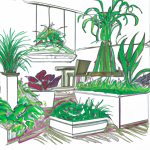Advanced Soil Management: Building the Foundation for Survival
When it comes to preparing for a crisis or disaster, one of the most important skills to possess is the ability to sustain yourself and your family. And at the heart of self-reliance is advanced soil management. You see, your ability to grow your own food hinges on the health and fertility of your soil. By understanding and implementing advanced soil management techniques, you can ensure a bountiful harvest even in the most dire circumstances. In this article, we will delve into soil types, nutrient management, and soil improvement techniques that will lay the foundation for your survival.
Understanding Your Soil: Types and Composition
The first step towards advanced soil management is understanding the type of soil you have. The three main soil types are sandy, clay, and loamy. Sandy soil is loose and drains quickly, while clay soil is dense and holds water. Loamy soil, on the other hand, is a perfect balance of sand, silt, and clay, providing good drainage while retaining moisture. Knowing your soil type will guide your nutrient management and improvement strategies.
Aside from soil type, it’s important to understand the composition of your soil. Healthy soil is made up of minerals, organic matter, air, and water. A balanced composition ensures a thriving ecosystem for your plants, allowing them to absorb nutrients and moisture efficiently.
Nutrient Management: Feeding Your Soil
In order to grow nutrient-rich crops, you must first ensure that your soil is well-nourished. Balanced nutrient management involves providing essential elements like nitrogen, phosphorus, and potassium (also known as N-P-K) to your soil. This can be achieved through various methods:
- Organic Matter: Adding compost, manure, or other organic materials to your soil improves its structure and nutrient content.
- Companion Planting: Pairing crops with different nutrient needs can help balance nutrient levels in the soil.
- Cover Crops: Planting cover crops like legumes or clover can fix nitrogen in the soil, reducing the need for synthetic fertilizers.
- Crop Rotation: Rotating crops helps prevent nutrient depletion and reduces the risk of pests and diseases.
By implementing these nutrient management techniques, you can ensure that your soil remains fertile and capable of sustaining your food production for the long haul.
Soil Improvement Techniques: Building Resilience
Advanced soil management goes beyond nutrient management and involves improving the overall health and resilience of your soil. Here are some techniques that will help you build a strong foundation:
- Cultivate Soil Biology: Encourage beneficial organisms like earthworms and beneficial bacteria by minimizing tillage and using natural soil amendments.
- Protect Soil Structure: Avoid excessive compaction and erosion by using mulch, cover crops, and terracing techniques.
- Enhance Water Retention: Increase the water-holding capacity of your soil by adding organic matter and using techniques like swales or keyline plowing.
- Test and Monitor: Regularly test your soil to ensure optimal pH levels and nutrient balance, making adjustments as needed.
By implementing these soil improvement techniques, you not only create a more productive garden but also ensure the long-term sustainability of your food production, even in the face of adversity.
The Time to Act is Now
In a world of uncertainty and potential crises looming, it is crucial to take action and arm yourself with the knowledge and skills for self-reliance. Advanced soil management is not only a means of survival but also a pathway to thriving in even the most challenging circumstances. By understanding your soil, managing nutrients, and improving its overall health, you are setting the stage for long-term food security. So, don’t wait for disaster to strike. Start implementing advanced soil management techniques today and build a solid foundation for your survival.




GIPHY App Key not set. Please check settings